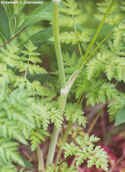Wild Chervil
Anthriscus sylvestris • Class B |
||
| Family Name: | Apiaceae family (ay-pee-AY-see-eye) | |
| Common: | Carrot/celery family (formerly Umbelliferae) | |
| Genus: |
Anthriscus (an-THRISS-kuss) Meaning: From the Greek and Latin name for another but unidentified plant |
|
| Species: |
sylvestris (sil-VESS-triss) Meaning: Of the woods, growing wild |
|
| Description: |
Wild Chervil is a biennial, or short-lived perennial that grows from 1 to 4 feet tall and reproduces by seed. Stems are hollow and ridged, with a fringe of hairs at the stem nodes. Leaves are alternate, shiny green, nearly hairless, and divided into smaller, fernlike leaves. The base of each leaf surrounds the stem. Its small 5 petaled white flowers are arranged in umbels at the top of the plant, instead of the leaf axils, like Burr chervil. Wild Chervil produces 2 joined seeds, about 1/4" long with 2 antennae-like styles at the top. Seeds are narrow, smooth, and shiny dark brown when ripe. |
| Why Is it a Noxious Weed? |
It has an aggressive growth habit and quickly creates a monoculture. It poses a serious threat to native plants and agriculture. |
| Where Does it Grow? |
It is highly adaptable and will grow in almost any type of soil. Wild Chervil is found on roadsides, forest edges and in waste areas. It grows mainly in poorly-drained soils, often on stream or ditch banks, and wet meadows. |
| Facts: |
Most of Pierce County is highly susceptible to Wild Chervil. |
| Control Options: |
|
| More Information: |
Download our Flyer or visit Washington State Noxious Weed Control Board Here. Photo by Leo Michels
|
| More Pictures: |







 Pierce County Noxious Weed Control Board • 9200 122nd St E, Puyallup, WA 98373 • 253-798-7263
Pierce County Noxious Weed Control Board • 9200 122nd St E, Puyallup, WA 98373 • 253-798-7263